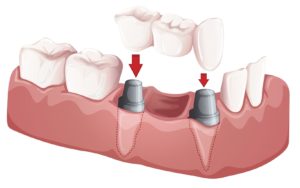A tooth bridge, commonly known as a dental bridge, is a fixed dental restoration that replaces one or more missing teeth by “bridging” the gap between adjacent teeth. This procedure is vital for maintaining oral health, as it prevents remaining teeth from shifting out of position, helps maintain facial shape, and restores your ability to chew and speak properly. There are various types of dental bridges, each designed to meet specific needs and situations, ensuring a personalized approach to dental care. The most common type, the traditional bridge, involves creating a crown for the tooth or implant on either side of the missing tooth, with a pontic in between.
This type of dental bridge is suitable for patients with natural teeth or implants on either side of the gap. A cantilever bridge is similar, but most applicable when abutting teeth exist on only one side of the missing tooth. The Maryland bridge, also known as a resin-bonded bridge, uses a metal or porcelain framework bonded to the back of adjacent teeth, making it a conservative option requiring less preparation. Lastly, the implant-supported bridge is perfect for patients with multiple missing teeth, relying on dental implants for support rather than adjacent natural teeth. Understanding what a dental bridge is and how it helps restore function and appearance is crucial in choosing the right type for your dental needs.
Dental Bridge Procedures: What to Expect
Obtaining a dental bridge begins with an initial consultation, where your dentist will assess your oral health and discuss your options. Typically, the procedure involves two or more visits. During the first visit, the dentist will prepare the abutment teeth by reshaping them to accommodate the crown. The dentist will take impressions of your teeth to create a model, which serves as the basis for crafting your bridge. The dentist may place a temporary bridge to protect the exposed teeth and gums while you await your permanent bridge. On your next visit, your dentist will remove the temporary bridge and check the fit of the new bridge, making necessary adjustments for comfort and function before permanently cementing it in place.
The longevity of a dental bridge depends on the care and maintenance it receives. Many patients wonder, “Is a dental bridge permanent?” While the short answer is ‘no’, dental bridges can last many years with proper care, typically ranging from 5 to 15 years or more. Post-procedure care is critical: maintain excellent oral hygiene by brushing and flossing twice daily and scheduling regular dental check-ups. Be mindful of potential complications such as loosened or damaged bridges, and know when to seek help. For any issues or dental emergencies, contact your dentist immediately. If you’re in the area, our professional dental bridge services in St. Catharines offer comprehensive care, providing expert guidance and support throughout the entire process to ensure your dental bridge meets all your functional and aesthetic needs.

